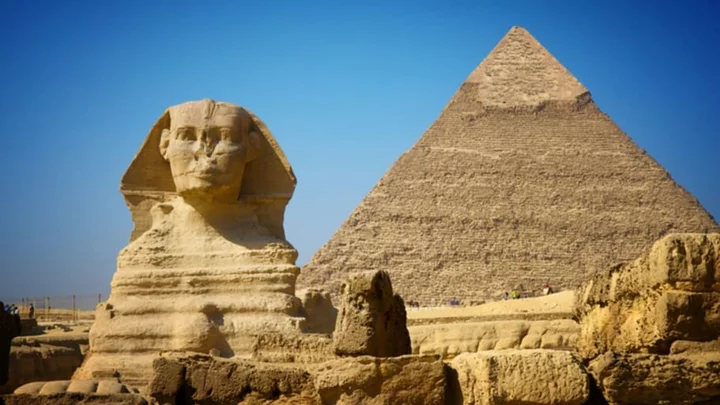The Great Sphinx of Giza is one of the oldest, largest, and most mysterious monuments ever created. Between its expansive mythology, nebulous origins, and alleged connections to worlds beyond our own, the Sphinx is a proverbial treasure trove of art and history. Here are a few things you might not have known about the towering desert dweller.
1. Technically, the Great Sphinx of Giza is not a sphinx.
Not a traditional sphinx, anyway. Although heavily influenced by Egyptian and Mesopotamian mythology, the classical Greek depiction of the sphinx consists of the body of a lion, the head of a woman, and the wings of a bird. Giza’s male-identifying landmark is, technically, an androsphinx. The lack of wings further muddles its accepted taxonomy.
2. The sculpture went by a few different names.
Ancient Egyptians didn’t originally call the behemoth creature “the Great Sphinx.” In the text on the Dream Stela of Thutmose IV from circa 1400 BCE, it’s referred to as a “statue of the very great Khepri.” When Thutmose IV slept next to it, he dreamed that the god Horem-Akhet-Khepri-Re-Atum came to him and revealed himself as Thutmose’s father. The god told him that if Thutmose cleared the sand around the statue, he would become ruler of all Egypt. After this event, the statue became known as Horem-Akhet, which translates as “Horus of the horizon.” Medieval Egyptians gave the Sphinx various monikers including balhib and bilhaw.
3. Nobody really knows who built the Great Sphinx.
The Great Sphinx of Giza is such a marvelous piece of work that it’s surprising nobody bothered to take credit for it. Even now, without definitive evidence of the statue’s age, modern archaeologists are split over which ancient Egyptian king created the landmark.
A popular theory is that the Sphinx emerging during the rule of Khafre, whose reign during the Fourth Dynasty of the Old Kingdom would give the statue a birth date in the neighborhood of 2500 BCE. The king is credited with the aptly named Pyramid of Khafre, the second largest structure of the Giza Necropolis, and of the adjacent valley and mortuary temples. This collection’s proximity to the Sphinx would tend to support the argument that Khafre was responsible for its development, as do the similarities between the Sphinx’s face and monuments of the king’s likeness.
However, without documentation of the age of the Sphinx, some scholars have suggested that the statue predates the works of Khafre. Some attribute construction to Khafre’s father, Khufu, the king who oversaw creation of the Great Pyramid of Giza, and to Khafre’s half-brother Djedefre. Others date the Sphinx back much further. Ostensible water damage to the face and head has prompted the theory that the Great Sphinx lived through an era during which extensive rainfall befell the region, which could peg the statue’s origins as early as 6000 BCE.
4. The Sphinx’s builders abandoned the job in a hurry.
Findings suggest that the Sphinx was originally intended to be an even greater accomplishment than what we see today. American archaeologist Mark Lehner and Egyptian archaeologist Zahi Hawass discovered large stone blocks, tool kits, and even lunches apparently abandoned midway through a workday.
5. Laborers who constructed the statue ate like kings.
Most scientists’ initial assumption was that the people who toiled to bring the Sphinx to life belonged to an enslaved caste. Their diets throw a wrench into that idea. Excavations led by Lehner revealed that the statue’s laborers regularly dined on luxurious cuts of prime beef, sheep, and goat meat, which suggests that the workers were professionals—or, possibly, that enslaved workers were given higher-quality foods to keep up their strength.
6. The Great Sphinx was once colorfully painted.
Though it is now indistinct from the drab tan of its sandy surroundings, the Sphinx may at one time have been completely covered in vivid paint. Remnants of red pigment can be found on the statue’s face, while hints of blue and yellow remain on the body.
7. The Sphinx spent time buried in sand.
The Great Sphinx has fallen victim to the shifting sands of the Egyptian desert several times during its long life. The first known restoration of the nearly completely buried Sphinx occurred just prior to the 14th century BCE, thanks to Thutmose IV, who would soon ascend to the throne as Egypt’s pharaoh. The three millennia that followed again buried the monument. By the 19th century, the statue’s front arms lived deep beneath the walking surface of Giza. It wasn’t until the 1920s that the statue would once again be fully excavated.
8. The Great Sphinx temporarily lost its crown.
During restoration in the 1920s, the Great Sphinx suffered the loss of part of its iconic headdress, as well as severe damage to the head and neck. Consequently, the Egyptian government employed a team of engineers to patch up the statue in 1931. But these restorations began wreaking havoc on the soft limestone, and in 1988, a 700-pound piece of the shoulder fell off in front of a German reporter. The government embarked on a massive restoration effort to undo the damage of earlier restorers.
9. A cult venerated the Great Sphinx long after it was built.
Thanks to Thutmose IV’s mystical vision at the Sphinx, the sculpture and its represented mythological deity began to win new popularity during the 14th century BCE. Pharaohs ruling over the New Kingdom even ordered the development of a new temple from which the Great Sphinx might be observed and revered.
10. The Egyptian sphinx is considered much kinder than its Greek cousin.
The Sphinx’s modern reputation for tyranny and trickery spawns not from Egyptian mythology, but Greek. The creature’s most famous appearance in ancient Greek lore came from her deadly run-in with Oedipus, whom she challenged with her allegedly unsolvable riddle. Ancient Egyptian culture valued its Sphinx as a much more benevolent, albeit no less powerful, godlike figure.
11. Don’t blame Napoleon for the Sphinx’s missing nose.
The mystery of the Great Sphinx’s lack of nose has generated all kinds of myth and speculation. The most pervasive of these legends blames Napoleon Bonaparte for blasting the protuberance away in a fit of militaristic pride. It’s a great story, but 18th century sketches of the Sphinx indicate that the statue’s dismemberment occurred before the French emperor was even born. Historical writings from the early 15th century CE accuse a devout Sufi Muslim named Muhammad Sa’im al-Dahr of defacing the monument in an effort to undermine the Sphinx worshippers. He was later killed.
12. The Sphinx went through a beard phase.
Today, remnants of the Great Sphinx’s beard, which was eventually shaved off the statue’s chin by erosion, live in the British Museum and in Cairo’s Museum of Egyptian Antiquities. However, French archaeologist Vassil Dobrev asserted in 2004 that the beard was not an original component of the statue but a later amendment. Dobrev backed up his hypothesis with the argument that removal of the beard would have resulted in damage to the statue’s chin, which isn’t readily apparent. The British Museum supported Dobrev’s assessment, proposing that the beard was added to the Sphinx at some point during or soon after Thutmose IV’s restoration project.
13. The statue is not the oldest sphinx in existence ...
The Great Sphinx of Giza is younger than other sphinxes carved during Egypt’s many dynasties. Even if you date the statue to Khafre’s reign in the Fourth Dynasty, sphinxes depicting his half-brother Djedefre and sister Hetepheres II are suspected to predate the Great Sphinx. New Kingdom pharaohs such as Hatshepsut were also depicted as the mythological beast.
14. ... But it is certainly the largest.
At 241 feet long and 66 feet high, the Sphinx is the largest one of its kind on Earth.
15. The Sphinx is the focus of astronomical theories.
The enigma of the Great Sphinx of Giza has made it a key part of a number of theories about the ancient Egyptians’ comprehension of celestial matters. Some scholars, such as Lehner, have discussed the Sphinx’s position, alongside the pyramids of the Giza Necropolis, in a massive “power harnessing machine” meant to digest energy from the sun. The proposal has its skeptics—but with a statue as mysterious as the Great Sphinx, the speculation isn’t likely to stop any time soon.
A version of this story was published in 2015; it has been updated for 2023.
This article was originally published on www.mentalfloss.com as 15 Things You Might Not Know About the Great Sphinx of Giza.









